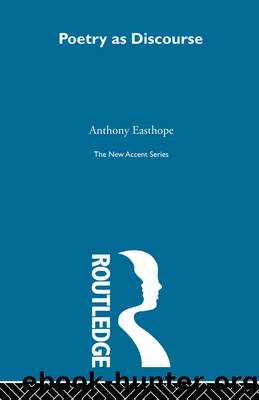Poetry As Discourse by Easthope Antony;

Author:Easthope, Antony;
Language: eng
Format: epub
Publisher: Routledge
Such rhyming works to throw a stress upon the meaning so that meaning dominates sound and the rhyme is subordinated. The more exact the rhyme, the greater this effect. Typical rhymes from Chaucer are called ‘tame’ by Wimsatt because ‘the same parts of speech are used in closely parallel functions’ (p. 160):
And he was clad in cote and hood of grene.
A sheef of pecock arwes, bright and kene …
Such rhymes treat the signifier not as subordinate to the signified but rather as in a relationship of equality with it, so that they tend to coincide. Relative to subordination, coincidence in rhyme emphasizes the phonetic, so acknowledging the dependence of signified or signifier. In coincident rhyme meaning is allowed to follow sound as much as sound does meaning; and the less exact the rhyme, the greater this effect, for example when only the vowels in the rhyme words have the same sound. ‘Bad’ rhyme draws attention to the phonetic, as it does in this couplet from a punk song of 1977:
I’m in love
With a girl I oughtn’t of.
Coincident rhyme foregrounds the signifier.
All the rhymes in ‘Three Ravens’ are monosyllabic or ‘masculine’ rhyme except ‘feete’/‘keepe’ (and then only if the final /e/ is pronounced) and ‘gentleman’/‘leman’ (and this strictly is not rhyme but homoeoteleuton, which occurs when two words have the same ending). Four rhymes are between the same parts of speech, ‘field’/‘shield’, ‘eagerly’/‘nie’, ‘backe’/‘lake’, ‘prime’/‘time’. Several are half-rhymes or assonance, ‘mate’/‘take’, ‘feete’/‘keepe’, and possibly ‘eagerly’/‘nie’ as well as ‘backe’/‘lake’ (depending on how they were pronounced at the time). Pope’s rhymes are like tendentious and non-tendentious jokes in Freud’s classification, phonetic play held in relation to the syntagmatic chain. These ballad rhymes are seen as ‘tame’ or ‘bad’ because, like the jest (‘When is a door …’) they are offered as a source of pleasure in themselves, as they would be for the 9-year-old cited by the Opies in The Lore and Language of Schoolchildren who says of a nonsense verse that ‘what’s so clever about this is the way it all rhymes’ (1967, p. 17).
Throughout ‘Three Ravens’ there is a foregrounding and insistence upon the material process of enunciation – in the use of four-stress metre (if it is spoken, not sung) and in the concurrence between semantic and phonetic, which brings meaning into parallel with the stanza, the line, the rhyme. In each stanza the first line is repeated three times for formal rather than semantic reasons. And crucially there is the refrain:
Downe a downe, hay down, hay downe …
With a downe …
With a downe derrie, derrie, derrie, downe, downe …
(a line referred to, though not necessarily from this ballad, at the end of Pound’s ‘Canto 83’, ‘Down, Derry-down’). In addition to occurring 80 times in the refrain, 8 times in each stanza, ‘down’ appears three times in the substantive couplets, when the body of the knight is said to be ‘downe’ in the field, when the hounds ‘lie downe’ at his feet, and when the doe comes ‘downe’. These
Download
This site does not store any files on its server. We only index and link to content provided by other sites. Please contact the content providers to delete copyright contents if any and email us, we'll remove relevant links or contents immediately.
4 3 2 1: A Novel by Paul Auster(11764)
The handmaid's tale by Margaret Atwood(7425)
Giovanni's Room by James Baldwin(6784)
Asking the Right Questions: A Guide to Critical Thinking by M. Neil Browne & Stuart M. Keeley(5340)
Big Magic: Creative Living Beyond Fear by Elizabeth Gilbert(5330)
Ego Is the Enemy by Ryan Holiday(4924)
On Writing A Memoir of the Craft by Stephen King(4650)
The Body: A Guide for Occupants by Bill Bryson(4562)
Ken Follett - World without end by Ken Follett(4430)
Bluets by Maggie Nelson(4245)
Adulting by Kelly Williams Brown(4216)
Eat That Frog! by Brian Tracy(4134)
Guilty Pleasures by Laurell K Hamilton(4104)
White Noise - A Novel by Don DeLillo(3820)
The Poetry of Pablo Neruda by Pablo Neruda(3804)
Fingerprints of the Gods by Graham Hancock(3723)
Alive: The Story of the Andes Survivors by Piers Paul Read(3717)
The Book of Joy by Dalai Lama(3677)
The Bookshop by Penelope Fitzgerald(3609)
